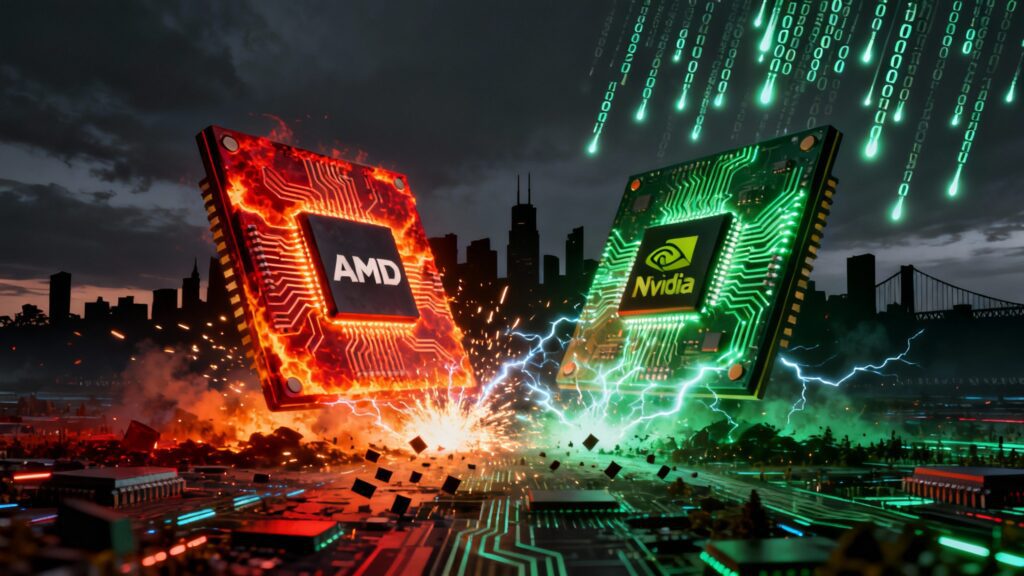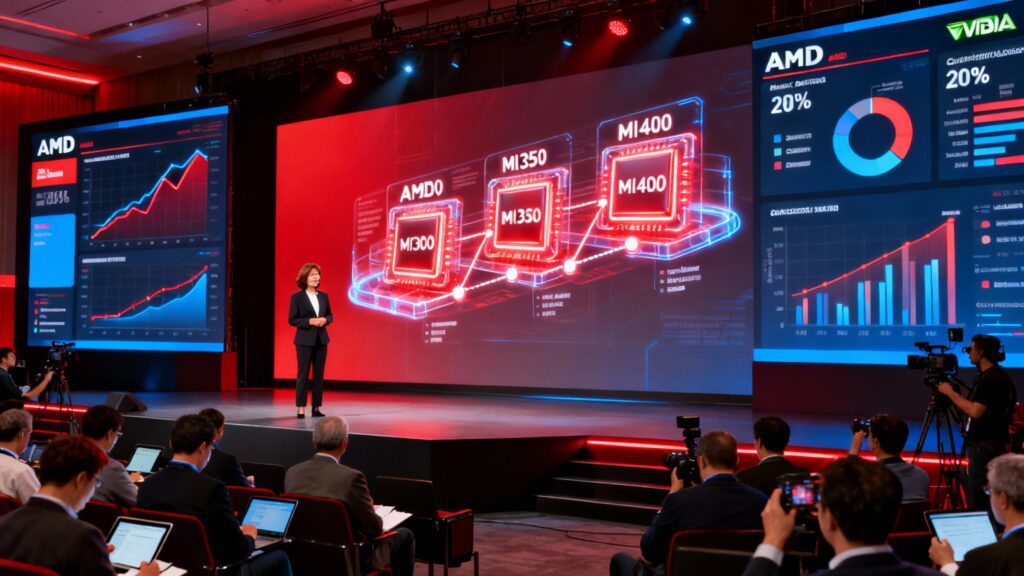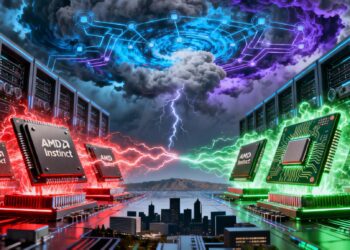
The semiconductor battlefield just got a whole lot more interesting. AMD has landed a knockout punch in the AI chip wars with a massive multi-year deal that could reshape the entire industry landscape.
The Deal That Shook Silicon Valley
On October 6, 2025, AMD and OpenAI announced a strategic partnership that sent shockwaves through the tech world. The agreement? OpenAI will deploy a staggering 6 gigawatts of AMD’s Instinct GPUs over multiple years. That’s enough computing power to run millions of homes—or train the next generation of AI models that could change everything.
AMD’s stock skyrocketed. We’re talking a 23.71% surge on Monday, marking the company’s biggest single-day gain since 2002. By midweek, shares had climbed an eye-popping 43%. Investors weren’t just excited they were ecstatic.
But here’s the kicker: This isn’t just about chips. AMD granted OpenAI a warrant for up to 160 million shares of AMD common stock. If OpenAI exercises the full warrant, they could own roughly 10% of AMD. The vesting is tied to deployment milestones and AMD’s share price hitting specific targets, with the final tranche unlocking when AMD stock reaches $600 per share.
Why This Changes Everything
For years, Nvidia has been the undisputed king of AI chips. The company controls approximately 80% of the AI accelerator market, thanks largely to its CUDA software ecosystem that’s become the industry standard. Over 4 million developers use CUDA, creating a massive competitive moat.
But AMD just crashed the party.
“This partnership is a major step in building the compute capacity needed to realize AI’s full potential,” OpenAI CEO Sam Altman said. And he’s not exaggerating. The deal is expected to generate tens of billions of dollars in revenue for AMD, according to the company’s CFO Jean Hu.
The Hardware Behind the Hype
So what exactly is OpenAI getting? The initial 1-gigawatt deployment, scheduled for the second half of 2026, will feature AMD’s next-generation Instinct MI450 Series GPUs. These aren’t your average chips.
AMD has been on a tear with its Instinct lineup. The current MI325X launched in late 2024, positioning itself as a direct competitor to Nvidia’s Blackwell architecture. The MI300X, its predecessor, boasts an impressive 192GB of HBM3 memory more than double Nvidia’s H100’s 80GB HBM2e.
Memory matters. A lot. When you’re training massive AI models or running inference at scale, memory capacity and bandwidth can make or break performance. AMD’s bet on high-memory configurations is paying off.
Nvidia’s Response: Surprise and Strategy
Nvidia CEO Jensen Huang didn’t hide his feelings about the AMD-OpenAI deal. Speaking on CNBC’s Squawk Box, Huang called the arrangement “unique and surprising.”
“I’m surprised that they would give away 10% of the company before they even built it,” Huang said. “It’s clever, I guess.”
But Huang has bigger fish to fry. Nvidia recently announced plans to invest up to $100 billion in OpenAI over the next decade, with OpenAI committing to deploy 10 gigawatts of Nvidia systems. That’s between 4 million and 5 million GPUs.
Altman was quick to clarify on social media that the AMD deal “is all incremental to our work with Nvidia” and that OpenAI plans to increase its Nvidia purchasing over time. “The world needs much more compute,” he wrote.
The Competitive Landscape Is Heating Up

AMD’s market share in AI GPUs has been hovering below 10%, but that’s changing fast. The company’s aggressive product roadmap includes annual releases: the MI350 series in 2025 and the MI400 series in 2026.
At AMD’s “Advancing AI 2025” event in June, CEO Lisa Su unveiled the company’s vision for an open AI ecosystem. The MI400 series will be the foundation of a new server called “Helios,” featuring 72 MI400 chips in a single rack-scale system directly comparable to Nvidia’s NVL72 servers.
“The future of AI is not going to be built by any one company or in a closed ecosystem,” Su declared. “It’s going to be shaped by open collaboration across the industry.”
That’s a not-so-subtle jab at Nvidia’s proprietary NVLink technology, which the company has only recently started licensing under competitive pressure.
Intel, Google, and Amazon Join the Fray
AMD isn’t the only company trying to chip away at Nvidia’s dominance. Intel’s Gaudi AI chips are positioned to be 50% cheaper than Nvidia’s H100, targeting cost-conscious enterprises. Intel’s AI chip revenue is projected to surpass $1 billion in 2024.
Meanwhile, the tech giants are building their own silicon. Google’s TPU v5 chips power AI workloads in Google Cloud, offering an alternative to traditional GPUs. Amazon’s Trainium and Inferentia chips aim to cut AI training costs by over 50% compared to Nvidia solutions for AWS users.
Even Tesla is getting in on the action with its Dojo AI chips, designed specifically for training self-driving models. Meta is developing custom AI chips too, aiming to reduce reliance on external suppliers.
The Software Challenge
Hardware is only half the battle. Nvidia’s CUDA ecosystem remains its secret weapon, with over 4 million developers creating a massive network effect. AMD’s competing software, ROCm (Radeon Open Compute), has struggled to gain traction despite being open-source.
But AMD is making progress. At its June event, the company emphasized improvements to ROCm, making it easier for developers to port AI models from CUDA to AMD hardware. The company has also made 25 strategic investments in the past year related to its AI plans, including hiring talent from AI startups like Untether AI and Lamini.
The Market Opportunity Is Massive
The AI chip market was valued at $20 billion in 2020. By 2030, it’s projected to exceed $300 billion a more than tenfold increase. AMD recently said the AI chip market could be worth $500 billion by 2028.
The market is growing at a compound annual growth rate of 30-40%, fueled by the explosion of AI applications across industries. From healthcare to finance to entertainment, AI is becoming fundamental infrastructure.
Nvidia’s data center revenue reached $18.4 billion in Q3 2023, up 279% year-over-year. The company’s stock surged over 240% in 2023, making it one of the best-performing tech stocks. Its market cap has climbed to $4.5 trillion.
What This Means for the Industry
Analysts at Bloomberg Intelligence believe AMD could capture 15% to 20% market share in a $500 billion market. That’s a significant chunk of change.
“Right now, Nvidia almost has a monopoly, with AMD having a low-single-digit share in the $250 billion market,” said Mandeep Singh, senior analyst at Bloomberg Intelligence.
The AMD-OpenAI deal gives the chipmaker credibility. After years of trailing Nvidia, AMD now has a flagship customer at the forefront of the generative AI boom. It’s validation that AMD’s chips can handle the most demanding AI workloads.
For OpenAI, the partnership provides supply chain diversification. Nvidia’s most advanced GPUs remain in short supply, with demand growing faster than production. By locking in access to AMD chips, OpenAI can keep scaling without waiting on Nvidia’s bottlenecks.
There’s also pricing leverage. “If OpenAI has more than one supplier, they have much more pricing leverage on buying chips than if they had only a single supplier,” said infrastructure analyst Jack Gold. “That could ultimately save them a great deal of money.”
The Power Problem
Here’s something that doesn’t get talked about enough: power consumption. One gigawatt is roughly equivalent to the power needed to run a midsized city like San Francisco at any given moment. OpenAI is committing to 6 gigawatts with AMD and 10 gigawatts with Nvidia.
That’s an enormous amount of electricity. The AI industry’s energy demands are becoming a serious concern, with data centers consuming increasing portions of the power grid. This is driving innovation in chip efficiency and renewable energy partnerships.
Trade Wars and Geopolitics
The chip wars aren’t just about technology they’re geopolitical. Nvidia has been caught in the crossfire of U.S.-China trade tensions. The company was doing roughly 25% of its GPU sales in China before export restrictions tightened.
In August, the Trump administration greenlit sales of certain chips to China, with Nvidia and AMD agreeing to give 15% of revenue from China sales to the U.S. government in exchange for export licenses. But China has since increased import restrictions on U.S. chips, including Nvidia’s processors.
The Commerce Department is also investigating whether Nvidia’s customer, Singapore-based Megaspeed, is helping China sidestep export restrictions. It’s a messy situation that highlights how AI chips have become a matter of national security.
What’s Next?
AMD’s partnership with OpenAI is just the beginning. The company is also working with other major players. At its June event, executives from Elon Musk’s xAI, Meta Platforms, and Oracle discussed their use of AMD processors. Cloud provider Crusoe announced plans to buy $400 million worth of AMD’s new chips.
The first AMD chips will arrive in OpenAI’s data centers in the second half of 2026. That gives AMD about 18 months to perfect its hardware and software stack. The pressure is on.
For Nvidia, the competition is welcome sort of. The company needs viable competitors to avoid antitrust scrutiny. In the 1990s, Intel needed AMD to exist as a viable No. 2 to help avoid monopoly charges. History might be repeating itself.
“This is a major win for AMD and shows that it has been putting the right strategy in place to take advantage of the AI mega-wave with its advanced GPUs,” said infrastructure analyst Jack Gold. “It’s also an endorsement that AMD has become competitive with Nvidia processing power.”
The Bottom Line
The AI chip wars are far from over. Nvidia still dominates, but AMD just proved it can compete at the highest level. With OpenAI as a marquee customer and a product roadmap that promises annual improvements, AMD is positioned for significant growth.
The real winners? Companies and developers who now have more choices. Competition drives innovation, lowers prices, and pushes the entire industry forward. As AI becomes more central to our lives, having multiple strong players in the chip market isn’t just good business it’s essential.
The semiconductor battlefield is heating up. And we’re all better off for it.
Sources
- AMD and OpenAI Announce Strategic Partnership to Deploy 6 Gigawatts of AMD GPUs
- OpenAI looks to take 10% stake in AMD through AI chip deal – CNBC
- AMD to supply 6GW of compute capacity to OpenAI in chip deal worth tens of billions – TechCrunch
- AMD launches MI325X AI chip to rival Nvidia’s Blackwell – CNBC
- AMD unveils AI server as OpenAI taps its newest chips – Reuters
- AMD Says New Chips Can Top Nvidia’s in Booming AI Chip Field – Bloomberg
- AMD deal with OpenAI gives Nvidia a needed challenger in AI chips – CNBC
- AMD stock soars after OpenAI deal – Fortune
- What is Nvidia, the world’s leading AI chipmaker – CNN Business
- Nvidia’s Huang says he’s surprised AMD offered OpenAI 10% of company – CNBC
- The AI Chip Market Explosion – PatentPC
- OpenAI Just Gave AMD a Big Win Against Nvidia – Business Insider










